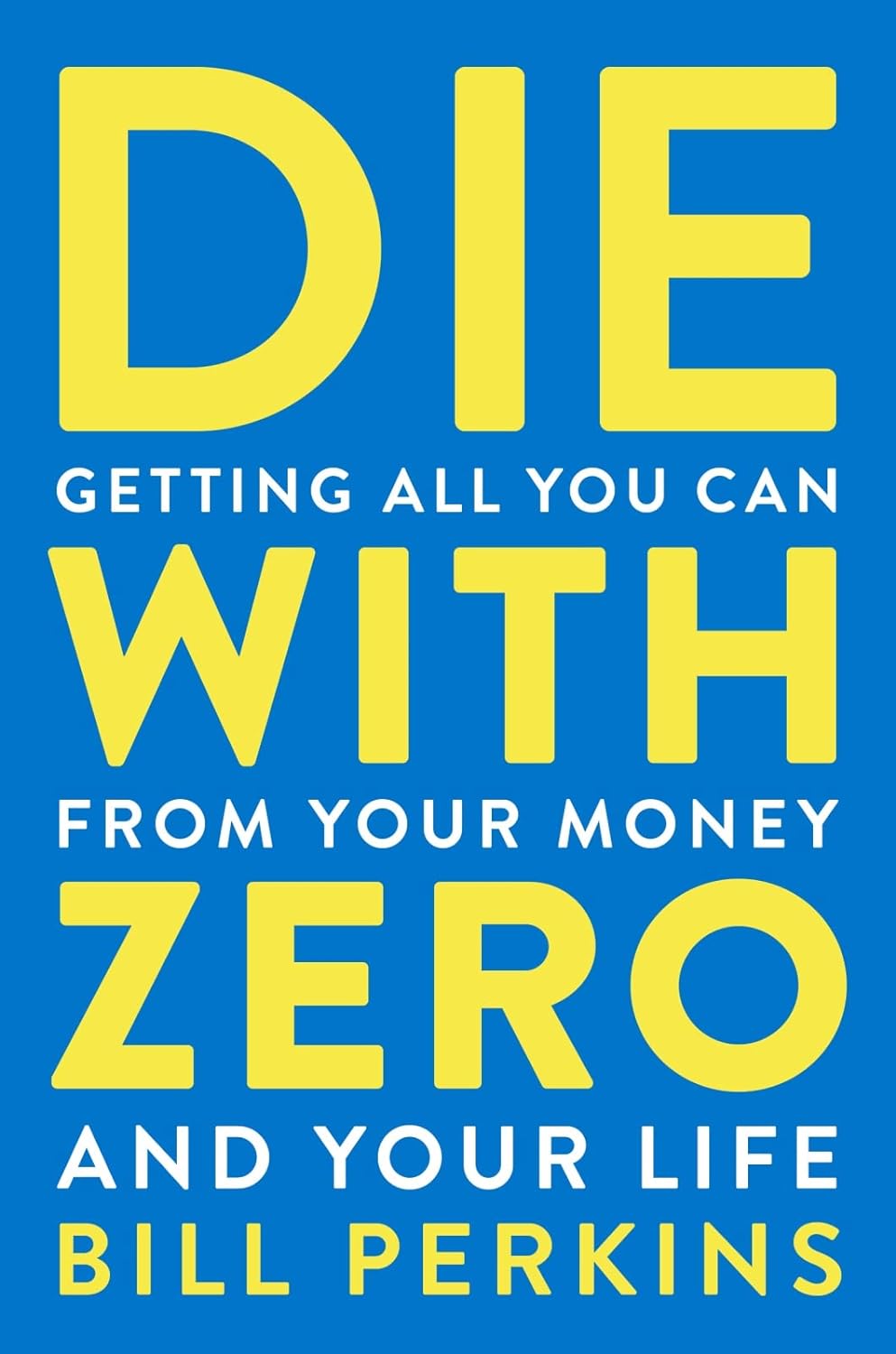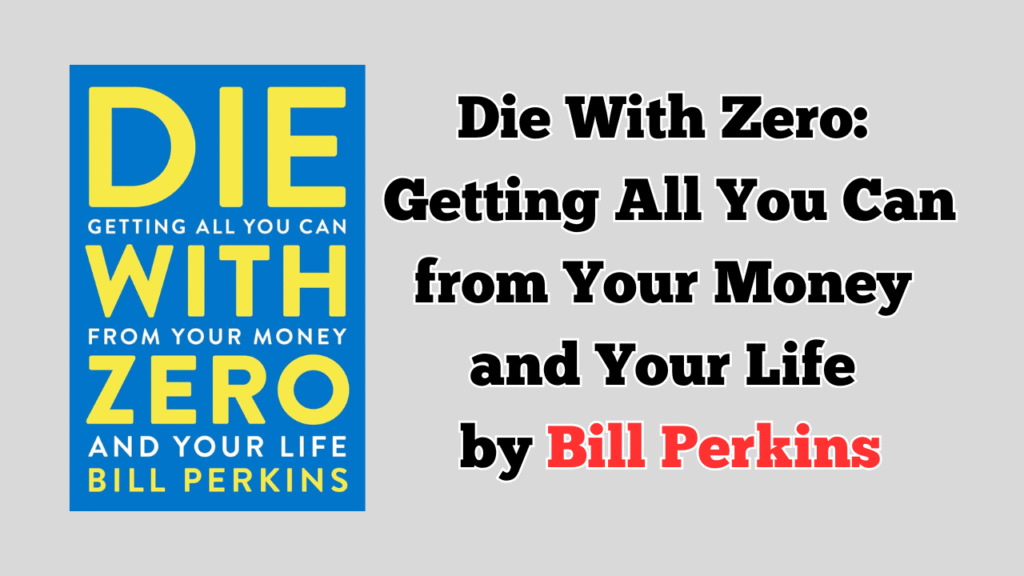
Die With Zero: Getting All You Can from Your Money and Your Life by Bill Perkins is more than a personal finance book—it’s a bold, countercultural guide to living a meaningful, intentional life. While traditional financial advice emphasizes saving, investing, and accumulating wealth for retirement and beyond, Perkins turns this model on its head. His core argument is simple but powerful: the goal should not be to die with a large bank account but to die having maximized life experiences.
Money is a tool to be used—not hoarded—for creating a fulfilling life. Perkins believes that time, not money, is the most precious commodity, and that understanding how to align our financial strategies with our life stages is key to truly living well.
The Core Philosophy: Die With Zero
Bill Perkins introduces a radical idea at the heart of his book: one should aim to die with zero dollars in the bank—not because they’ve been wasteful, but because they’ve extracted the maximum utility from their money through meaningful life experiences. For Perkins, the idea of leaving a large inheritance or amassing wealth for its own sake misses the point of life. He advocates for deliberate “spending down” of assets in ways that enhance life, deepen relationships, and create lasting memories.
Why Die With Zero?
The logic behind dying with zero centers on the inefficiency of over-saving. People, driven by fear or conventional wisdom, often work longer than necessary and deny themselves enjoyment during their most vital years. By the time they feel “ready” to spend or explore, their health, energy, or opportunities may have diminished. This, Perkins argues, is a tragic misallocation of resources.
Instead, he suggests tracking one’s “net fulfillment” rather than just net worth. Fulfillment is maximized when money is spent at the right times in life—on experiences, not just possessions. Perkins is not suggesting reckless spending, but purposeful allocation of resources with the end goal being a life rich in meaning rather than just in money.
Timing Is Everything: Experience Has a Shelf Life
A major theme in Die With Zero is the concept of timing. Perkins insists that certain experiences must be had at the right age to be most valuable. For instance, hiking through Machu Picchu in your twenties offers a different—and often better—return on investment than doing it in your sixties.
He introduces the idea of an experience curve, where the value of certain experiences declines over time. Physical limitations, changes in interest, or life responsibilities can make once-dreamed-of adventures impractical. Therefore, deferring joy for decades is not wise—it risks never being able to enjoy those things at all.
The Memory Dividend
One of Perkins’ most unique concepts in Die With Zero is the “memory dividend.” When you invest in experiences, you’re not just paying for the activity—you’re also creating a reservoir of memories that continue to pay emotional dividends throughout life. A vacation in your thirties, for example, might bring joy for decades through recollection, stories, photos, and bonds formed. This contrasts with material purchases that may quickly depreciate or be forgotten.
He argues that creating a rich bank of memories is a form of wealth more meaningful than a growing stock portfolio. In this sense, experiences appreciate in value emotionally over time, even if their monetary cost was high at the outset.
Health, Wealth, and Time: The Intersecting Triangle
Perkins introduces a triad that shapes all human experience: health, wealth, and time. He highlights that we rarely have all three in abundance simultaneously:
- In our youth, we have time and health, but little wealth.
- In middle age, we may have wealth and health, but less time.
- In old age, we often have wealth and time, but diminishing health.
The key, then, is to balance this triangle wisely and make decisions that recognize these life stages. He urges readers to spend their money during periods where the returns (in experience and joy) will be highest. Too many people sacrifice the best years of their lives working for a distant “one day,” which may never come.
Calculated Risk and Financial Planning
Despite his provocative message, Perkins is not suggesting people throw caution to the wind. In fact, he encourages precise financial planning—only with a different goal than the traditional retirement plan. He recommends people calculate how much money they will need to meet obligations and then thoughtfully spend the rest on experiences that matter most.
Die With Zero introduces the idea of “time bucketing,” where one organizes life into decades or phases and plans which experiences best fit into which timeframe. This approach emphasizes intentional living, ensuring that you’re not just drifting through life waiting for the “right” time to do things.
Perkins also recognizes that unforeseen events can derail plans, so he doesn’t dismiss the importance of insurance or emergency funds. What he critiques is the accumulation of wealth without purpose.

On Giving: The Inheritance Trap
A significant section of Die With Zero addresses inheritance, which Perkins sees as an often-misguided goal. He argues that giving away wealth upon death is inefficient—especially since the recipients (typically children) are often in their 50s or 60s by then, already established in life and past the point where money can be most impactful.
Instead, he encourages “timely giving”: giving money when it will do the most good. Helping a child with college, travel, or starting a business in their 20s or 30s can change the trajectory of their life. The same amount given at 60 is unlikely to have the same transformative power.
He reframes giving not as inheritance but as capital allocation, encouraging people to think of themselves as stewards of resources that should be deployed for maximum return—whether for themselves or loved ones.
Criticisms and Caveats
Perkins’ philosophy is compelling, but it’s not without criticism. One critique is that Die With Zero may seem out of touch with the financial realities of many. For those living paycheck to paycheck or burdened with debt, discussions about travel, “time bucketing,” or planning legacy gifts may feel abstract or irrelevant.
Additionally, some readers may feel uncomfortable with the idea of intentionally spending down to zero, especially in a society where safety nets are weak and lifespans are uncertain. The fear of running out of money in old age is real, and not easily dismissed by anecdotes or averages.
Perkins addresses this by suggesting annuities or guaranteed income streams to ensure a base level of security, but the emotional resistance remains a barrier for many. Also, cultural and family obligations may dictate different priorities for wealth management and legacy.
Impact and Legacy of the Book
Since its release, Die With Zero has sparked wide debate. It has been praised for its refreshing honesty, existential courage, and practical steps toward life optimization. It’s especially resonant for people approaching middle age or contemplating retirement, offering a framework to rethink how they’re spending their most limited resource: time.
The book contributes to a growing cultural shift away from the “grind and save” mentality toward lifestyle design and values-based spending. In an age where many are rethinking work-life balance, the gig economy, and personal meaning, Perkins’ message is timely and potent.
Real-World Application: Living the Message
For those inspired by Die With Zero, putting the philosophy into practice requires more than just a mindset shift. It means:
- Evaluating current and future cash flows to see what can be spent now.
- Setting experience goals—things to do before a certain age.
- Reassessing what wealth means, with a shift toward fulfillment, not accumulation.
- Having hard conversations with family about legacy, giving, and expectations.
- Creating a personal memory portfolio, not just a financial one.
It also demands regular reflection: Are you living for today or deferring joy indefinitely? Are you saving for the sake of saving, or for a meaningful end? What do you really want out of life, and are your financial decisions aligned with those values?
Conclusion: A Call to Live Intentionally
Die With Zero is ultimately a philosophical manifesto wrapped in a personal finance guide. Bill Perkins doesn’t just want you to manage money better—he wants you to live better, with clarity, courage, and purpose. He challenges the reader to reconsider deeply embedded beliefs about wealth, security, and legacy, pushing for a more intentional approach to life’s fleeting years.
By encouraging people to spend wisely and live fully—not someday, but now—Perkins offers a liberating framework. Whether or not one embraces every aspect of his advice, the book succeeds in its primary mission: prompting a serious reevaluation of how we trade our money, time, and health for the life we ultimately get to live.
If you found this review useful please share it with friends and family and then check out some of our other Book Reviews.
.

Interesting idea